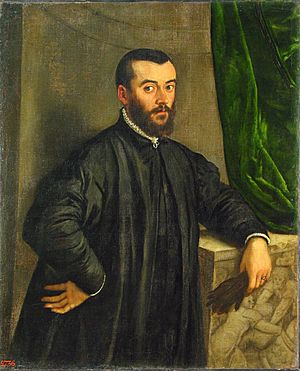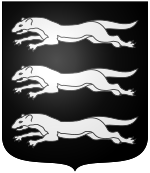Andreas Vesalius facts for kids
Quick facts for kids
Andreas Vesalius
|
|
|---|---|

Portrait by Jan van Calcar
|
|
| Born |
Andries van Wezel
31 December 1514 |
| Died | 15 October 1564 (aged 49) |
| Education | University of Leuven (M.D., 1537) University of Paris |
| Known for | De humani corporis fabrica (On the Fabric of the Human Body) |
| Scientific career | |
| Fields | Anatomy |
| Institutions | University of Padua (1537–1542) |
| Thesis | Paraphrasis in nonum librum Rhazae medici Arabis clarissimi ad regem Almansorem, de affectuum singularum corporis partium curatione (1537) |
| Academic advisors | Johann Winter von Andernach Jacques Dubois Jean Fernel |
| Notable students | John Caius Realdo Colombo Gabriele Falloppio |
| Influences | Galen Gemma Frisius Johannes Baptista Montanus |
| Signature | |
 |
|
Andreas Vesalius (born Andries van Wezel) was a famous scientist from the 1500s. He was an anatomist, a physician, and a writer. He wrote one of the most important books about the human anatomy called De Humani Corporis Fabrica Libri Septem. This book was a huge step forward in understanding the human body.
Many people call Vesalius the founder of modern human anatomy. He was born in Brussels, which is now part of Belgium. He taught at the University of Padua and later became a doctor for Emperor Charles V.
His name, Andreas Vesalius, is the Latin version of his Dutch name, Andries van Wesel. It was common for scholars back then to use Latin names.
Contents
Early Life and Learning
Vesalius was born on December 31, 1514, in Brussels. His family had a long history in medicine. His great-grandfather taught medicine, and his grandfather was a royal physician. His father was an apothecary (like a pharmacist) for Emperor Charles V.
His father wanted him to follow the family tradition. So, Vesalius learned Greek and Latin, which were important for studying medicine. In 1528, he started studying arts at the University of Leuven.
Later, he moved to the University of Paris in 1533 to study medicine. There, he learned about the theories of Galen, an ancient Greek physician. Vesalius became very interested in anatomy. He often studied bones he found in old burial grounds. He even built his first skeleton from bones he found.
In 1536, he had to leave Paris because of a war. He went back to the University of Leuven and finished his studies. He earned his medical degree the next year.
Medical Career and Discoveries
Right after graduating, Vesalius was offered a job. He became a professor of surgery and anatomy at the University of Padua. He also gave guest lectures at other universities. Before starting his job, he traveled through Italy. He helped people suffering from leprosy.
In 1542, he met an artist named Jan van Calcar. Together, they published Vesalius's first anatomy book in 1538. Before Vesalius, anatomy was mostly taught by reading old texts, especially those by Galen. A barber-surgeon would do a dissection, but the lecturer just read from a book. No one tried to check if Galen's ideas were correct.
Vesalius changed this. He did the dissections himself and encouraged his students to do them too. He believed that seeing things with your own eyes was the best way to learn.
Anatomical Illustrations
Vesalius made detailed drawings of anatomy for his students. These were large woodcut posters. When he saw that others were copying them, he published them all in 1538. In 1539, he updated an anatomy handbook.
He also wrote about bloodletting in 1539. This was a common treatment, but there was debate about how to do it. Vesalius generally supported Galen's method but added his own ideas.
Correcting Galen
In Bologna, Vesalius realized something important. Galen's research was based on dissecting animals, not humans. In ancient Rome, dissecting human bodies was not allowed. Galen had dissected Barbary macaques, thinking they were very similar to humans. Because of this, Galen's research had many mistakes.
Vesalius was the first to point out that Galen had used animal anatomy instead of human anatomy. This mistake had gone unnoticed for 1,400 years! Vesalius was able to get a regular supply of human bodies for dissection. In 1539, a judge in Padua agreed to give him bodies of criminals who had been executed.
Galen believed that arteries carried pure blood from the left side of the heart to organs like the brain. He thought veins carried blood from the right side of the heart to other organs. To make this work, he thought there must be holes connecting the two sides of the heart. For centuries, doctors claimed to find these holes. But Vesalius looked closely and admitted he could not find them. He still couldn't fully explain blood flow, but he was honest about what he saw.
Vesalius also proved other Galen mistakes. He showed that the lower jaw (the mandible) is one bone, not two. Galen had thought it was two, based on animal dissections. Vesalius also found that humans do not have a special network of blood vessels in the brain called the rete mirabile, which sheep have.
The Basel Skeleton
In 1543, Vesalius publicly dissected the body of a criminal in Basel, Switzerland. He put the bones back together to create a skeleton. He gave this skeleton to the University of Basel. This "Basel Skeleton" is the oldest surviving human skeleton prepared for study. You can still see it today!
De humani corporis fabrica
In the same year, Vesalius helped publish his most famous work, De humani corporis fabrica (On the Fabric of the Human Body). This seven-volume book was a huge breakthrough in human anatomy. Many believe it was illustrated by Jan Van Calcar, a student of Titian. The book had 273 detailed illustrations.
Vesalius also published a shorter version for students. His Fabrica book was revolutionary. It changed how medical books were made and helped make anatomy a modern science. Vesalius was only 28 years old when it was first published. The book was so popular that copied versions appeared almost immediately.
Imperial Doctor and Final Journey
Soon after his book was published, Vesalius was asked to be the doctor for Emperor Charles V. He accepted the job and left his teaching position. He married Anne van Hamme and they had one daughter, Anne.
For the next eleven years, Vesalius traveled with the Emperor's court. He treated injuries from battles and tournaments. He also performed autopsies and wrote letters about medical questions. During this time, he wrote about a medical plant called "China root." He also defended his anatomical findings, which led to more criticism.
In 1551, Emperor Charles V asked for an investigation into Vesalius's methods. Even though his work was cleared, the attacks continued. One of his old teachers even claimed that the human body itself had changed since Galen's time!
In 1555, Vesalius became a doctor for Philip II, the Emperor's son. He also published a new version of De humani corporis fabrica.
In 1564, Vesalius went on a trip to the Holy Land. Some people thought he went because he was accused of dissecting a living person. However, modern historians believe this story is not true. It was likely a way for him to leave his royal service, which he didn't enjoy. He wanted to continue his research.
On his way back, his ship was caught in bad weather. He was shipwrecked on the island of Zakynthos in Greece. He died there at 49 years old. He was buried somewhere on the island.
Scientific Discoveries
Vesalius made many important discoveries that changed how we understand the human body.
Skeletal System
- Vesalius saw the skeletal system as the body's main support.
- He proved that the lower jaw is one bone, not two, as Galen thought.
- He correctly described the inside of the temporal bone in the skull.
- He found that the human sternum (breastbone) has three parts, not seven like Galen thought (based on apes).
- He showed that men and women have the same number of ribs.
- He noted that the leg bones (fibula and tibia) are larger than the arm bone (humerus), correcting Galen.
Muscular System
- Vesalius's most famous contribution to muscles was the amazing illustrations in De fabrica. These are known as the "muscle men."
- He described where each muscle starts and ends, and how it works.
Blood and Circulation
- Vesalius's work on the vascular (blood vessel) and circulatory systems was very important.
- He found that Galen's idea of holes in the interventricular septum (the wall between the heart's chambers) was wrong. He saw that the septum was solid.
- He also discovered and named the mitral valve in the heart.
- He believed that the heart's pumping (systole) happens at the same time as the pulse in the arteries.
- He described the azygos vein and a special canal in a fetus.
Nervous System
- Vesalius said that nerves carry feeling and movement. He proved that ligaments and tendons are not types of nerves.
- He believed the brain and nervous system control the mind and emotions. This was different from the common idea that the heart was the center of the body.
- He showed that nerves come from the brain, not the heart.
- By studying the optic nerve (for sight), he concluded that nerves are not hollow.
Abdominal Organs
- In De fabrica, he corrected his earlier mistake about the right kidney being higher than the left.
- He said that kidneys filter blood, not just urine.
- He described the omentum (a fatty tissue in the belly) and its connections.
- He gave the first good description of the pylorus (part of the stomach).
- He observed the small size of the appendix in humans.
- He also gave a good account of the mediastinum and pleura (parts of the chest).
- Vesalius found that the uterus was incorrectly described as having two sections.
Heart
- Vesalius thought that true muscles move voluntarily. Since the heart moves on its own, he concluded it was not a "true" muscle.
- He identified two chambers and two upper parts (atria) in the heart.
- He avoided discussing if the heart was the center of the soul, to avoid religious conflict.
- He confirmed there were no holes in the septum (wall) of the heart, going against Galen's theory.
Other Achievements
- Vesalius proved that men and women have the same number of teeth.
- He helped introduce a surgical way to drain empyema (pus in the body).
- His study of the human skull helped start the study of physical anthropology (the study of human physical features).
- Vesalius always told his students to check their own findings and even his.
- He worked on medical treatments.
- He believed medicine had three parts: drugs, diet, and "the use of hands" (surgery and anatomy knowledge).
- He supported "parallel dissections," where an animal and a human body were dissected at the same time. This helped show the differences and correct Galen's errors.
Lasting Impact
Vesalius's detailed drawings of the human body were very influential. Later artists, like Pietro da Cortona, used similar styles in their anatomical drawings.
In 1844, a plant genus called Vesalea was named in his honor.
See also
 In Spanish: Andrés Vesalio para niños
In Spanish: Andrés Vesalio para niños
- Androtomy
- Brain Renaissance
- InVesalius
- Medical Renaissance
- Physician writer
- Timeline of medicine and medical technology
- Vesalius College

